This is part of my ongoing series in which I compare four translations of Final Fantasy VI with the original Japanese script. For project details and my translation notes from Day 1, see here.
Part 14: Kefka’s Tower & Ending
We’ve finally reached the last area of the game. I wanted to give this part of the game its own dedicated stream and page, so it’ll probably be a little shorter than the previous pages.
Also, after this update there’ll be one more update that summarizes the different translations, the kinds of things we discovered during this big comparison project, and some of my own final thoughts.
Video Archive
Notes
As always, my notes below only cover a portion of the topics I covered during the live stream. So if you’d like to see and learn even more about the game’s translations, translation mistakes, trivia, and more, see the video above.
Atma Buster
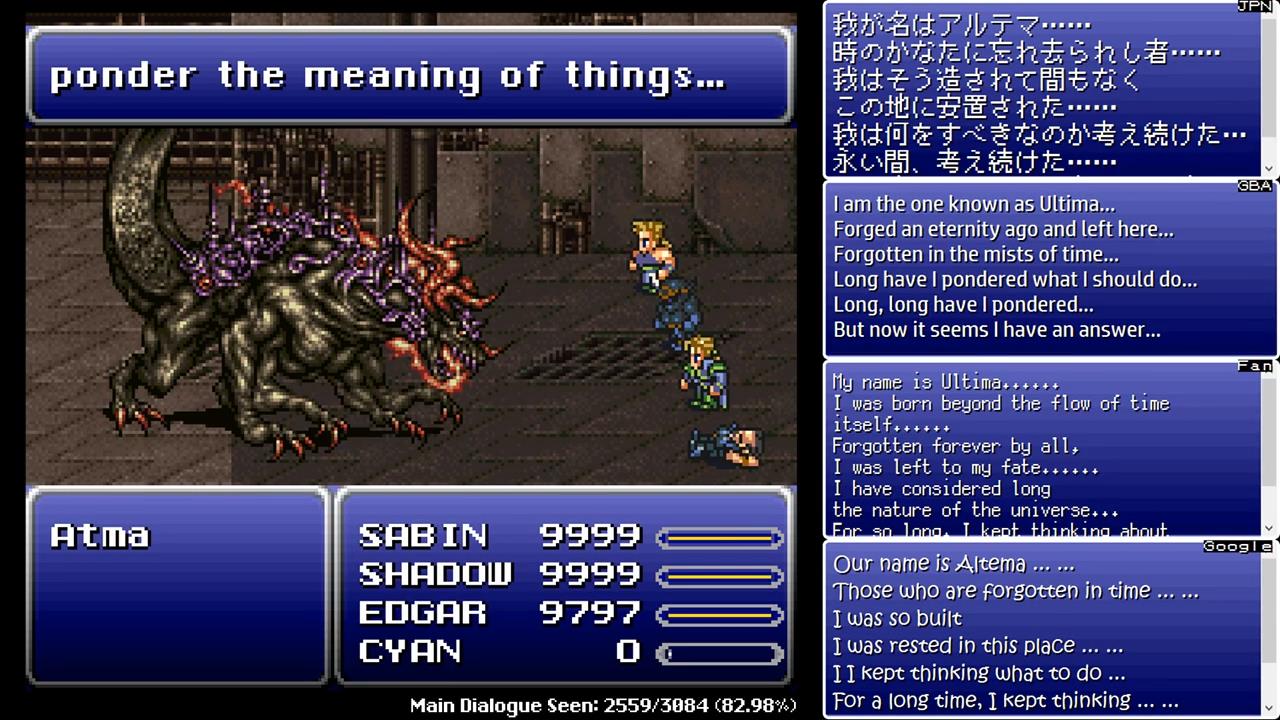
In Kefka’s tower there’s a creature sitting inside a jail cell-like room. The stuff it says in battle is a little more complicated than usual text, so the fan translation stumbles and gets the majority of the text wrong. The Super NES translation isn’t too far off the mark, but it had to be shortened to fit. Only the GBA version properly conveys the full meaning of the original text.
There is one detail that has me curious, though: in Japanese, the monster says it “was placed here/on this land/in this place shortly after being created”. But Kefka’s tower has only existed for a year, which leaves it open to interpretation that it’s only a year old too. In which case, all the talk about being long forgotten and having a long time to think is unintentionally amusing and kind of makes me feel bad for it. After all, it’s some super-powerful and almighty being, but was left to rot in a jail cell with a toilet. I’ve seen some Japanese fans joke about this very thing, in fact.
Of course, I guess if you take it less literally and assume “here” refers to this planet or this dimension or something, then that could work.
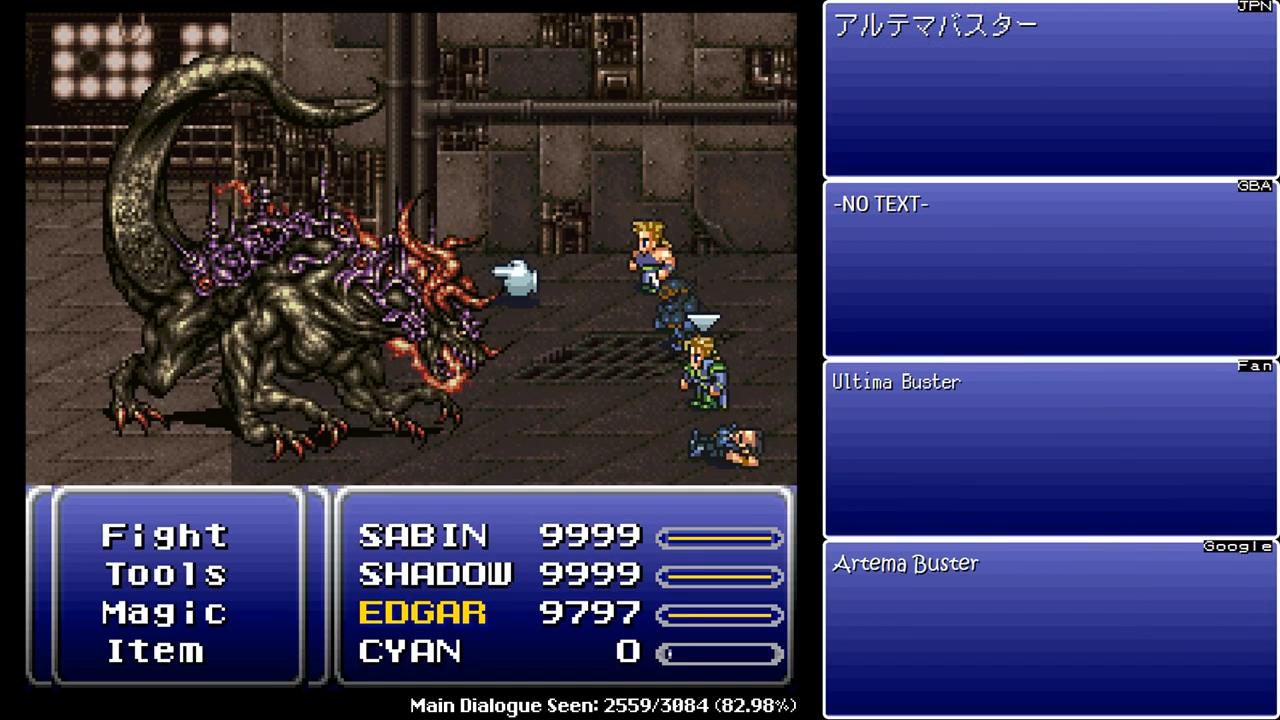
Incidentally, this monster is known as the アルテマバスター (arutema basutā) in the original Japanese script. There was a similar monster named アルテマウェーポン (arutema wēpon) back on the Floating Continent. In this particular battle, the enemy introduces itself as just アルテマ (arutema), though. So, wait, is this the same monster as before but in a new form, or is it completely different?
I don’t really know the answer, but this does remind me of another question about the monster’s name. By itself, バスター (basutā) would be translated as “Buster” probably 99% of the time without even much thought needed. But I do recall hearing some fans theorize that basutā is intended as the English word “bastard” here, meaning that this monster is a sort of strange variant or maybe even a fake.
I never put much thought into this bastard theory, but it is true that basutā can be used as an abbreviation for バスタード (basutādo, "bastard") – for example, the “bastard bunt” in Japanese baseball is often just called basutā for short.
The fan theory then goes on to point to things like Cloud’s “Buster Sword” in Final Fantasy VII and how it was probably intended to mean “Bastard Sword”. I think there’s another example or two that gets brought up too.
I don’t know if I buy into the theory, but I thought it was interesting enough to share here anyway, especially given how the monster introduces itself. Now that I think about it, this feels similar to the whole Siegfried/Ziegfried thing in the Super NES translation, but with a different twist to it.
Crusader Magicite
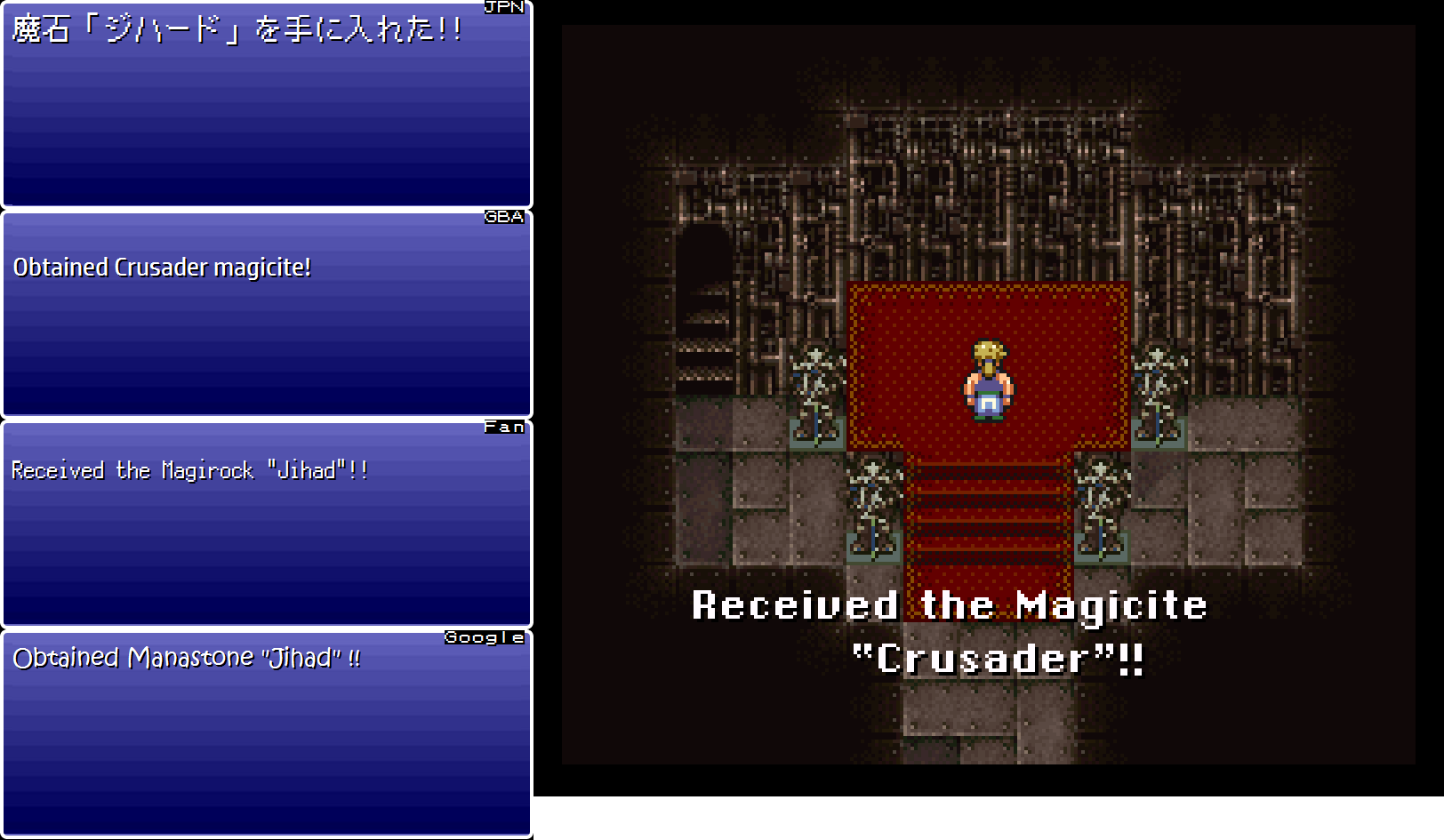
This has been known for years and years, but the “Jihad” Magicite/Esper was renamed “Crusader” for the Super NES release. I’m guessing that the original name was considered a little too religiously iffy or politically controversial. Interestingly, the replacement also has religious connections, but I guess “crusader” is used often enough in non-religious situations in American English that it’s not as inflammatory of a word.
I’ve always been curious about the details of the word “jihad” though, so I took a quick look at Wikipedia:
Jihad is an Arabic word which literally means striving or struggling, especially with a praiseworthy aim. It can have many shades of meaning in an Islamic context, such as struggle against one’s evil inclinations, an exertion to convert unbelievers, or efforts toward the moral betterment of society, though it is most frequently associated with war.
When I look for “crusader” on Wikipedia, it just says “a participant in one of the Crusades”. Still, for the sake of comparison, here’s how the Crusades are explained:
The Crusades were a series of religious wars sanctioned by the Latin Church in the medieval period. The most commonly known Crusades are the campaigns in the Eastern Mediterranean aimed at recovering the Holy Land from Muslim rule, but the term “Crusades” is also applied to other church-sanctioned campaigns. These were fought for a variety of reasons including the suppression of paganism and heresy, the resolution of conflict among rival Roman Catholic groups, or for political and territorial advantage. At the time of the early Crusades the word did not exist, only becoming the leading descriptive term around 1760.
It’s probably just a weird coincidence, but it’s interesting how the two Esper names sort of parallel each other but also represent two opposite sides of historic religious conflicts.
Also, I’m pretty sure I knew the word “jihad” by the time the Super NES version of Final Fantasy VI was released, but I don’t recall how well known it was in general in America at the time. It’s definitely much more well known now, but I wonder how problematic or noticeable the name “Jihad” would’ve been if the translation had left it as-is.
Anyway, the GBA translation kept it as “Crusader”. The choice to keep it unchanged is intriguing, given that some other Esper names were revised for the GBA release. Both the fan translation and the machine translation keep the name as “Jihad”.
Magical Three
The three magical statues from earlier in the game now appear in living form as powerful bosses. I always mix up how two of their names were translated, so for my own future reference I decided to look into them here.

This first magical being is known as 魔神 (majin) in the Japanese battle script, which can also be spelled as まじん as seen in the enemy name window above. As always, anything that has the 魔 (ma) character is a bit tricky to translate. For more on this topic, see my in-depth article about 魔王 (maō) here.
In very rough terms, this particular majin can be translated as something like “demon god”. In this case, the Super NES translator went with “Doom”. I assume one reason is that both “demon” and “god” were prohibited religious terms at the time. Enemy name length limits might’ve been another reason.
The translator also named a magic spell in the game “Doom”, so it’s odd to see a major boss with the exact same name. I guess it happened before with Ultima, though.
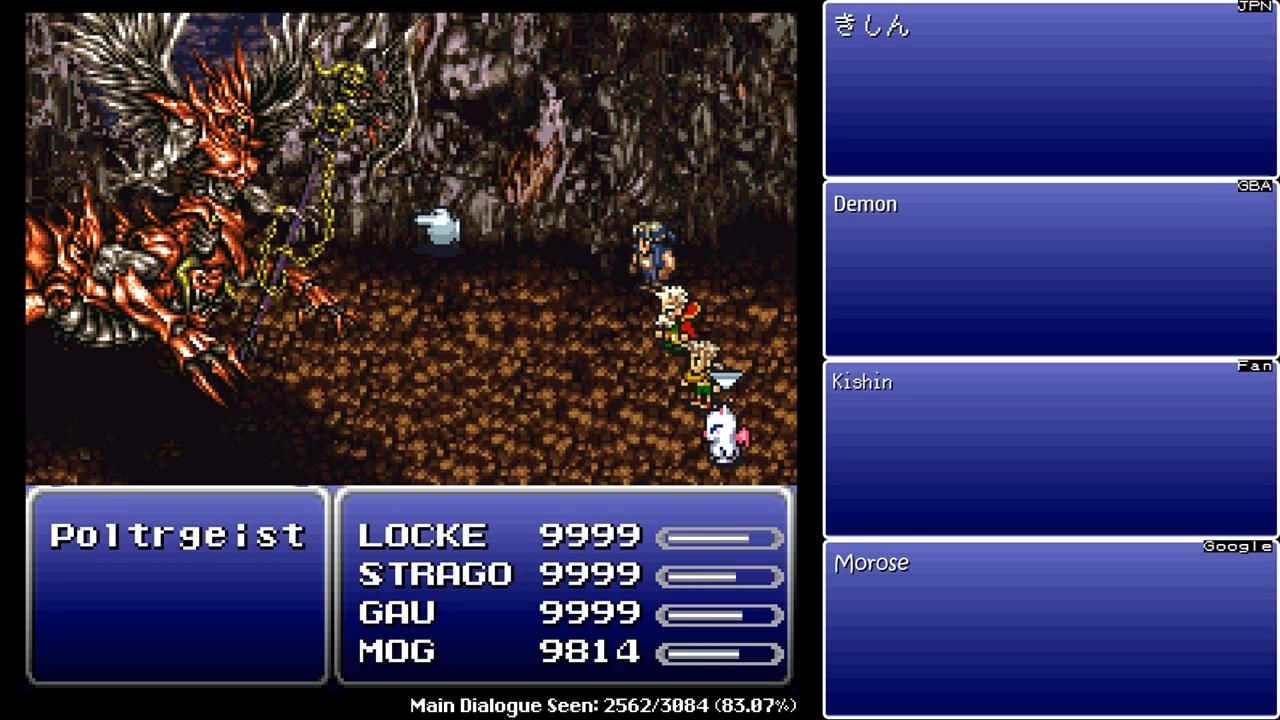
Next is a much weirder looking creature known as 鬼神 (kishin) in Japanese, which can also be spelled as きしん as we see above. This is another difficult name to translate, primarily because the character 鬼 can refer to a Japanese oni, evil spirits, demons, ogres, and other things of that nature. The second character, 神, generally means “god” or “deity”.
There’s rarely a good single translation for words like this, and in my own career I’ve had to use a couple different solutions for kishin. In this case, the Super NES translator went with “Poltrgeist”, which is a compressed version of the word “poltergeist”. The GBA translator changed this simply to “Demon”, while the fan translator left it untranslated as “Kishin”. Google got confused and translated the name as “Morose”.
This kishin term doesn’t come up as often in Japanese entertainment as majin, but if you’ve seen either one translated in other entertainment, let me know. If I can gather up enough stuff about these words, I can give them their own dedicated articles too.

Last is this magical lady known as 女神 (megami) in Japanese, which can also be spelled as めがみ. This is a very common term that usually translates as “goddess”. Indeed, both the Super NES and GBA translation call her “Goddess”. For some reason, the fan translation and the machine translation leave it untranslated as “Megami”.
The Super NES version of this boss was also slightly edited to cover her up a little more:
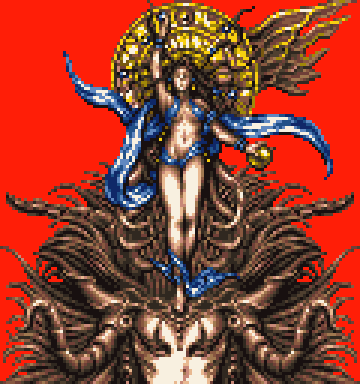 | 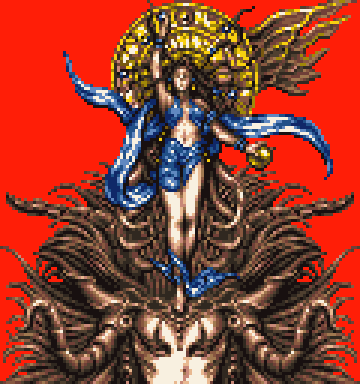 |
| Japanese version | Super NES version |
I guess the original Japanese image was a little too indecent for someone somewhere. Incidentally, if you like seeing the graphical changes in this game, check out The Cutting Room Floor’s FFVI graphical changes section – it lists many other examples, some of which I haven’t covered here.
Kefka’s Thinking
The heroes reach Kefka at the top of his tower. Kefka mocks the party and also shares a peek into his way of thinking.
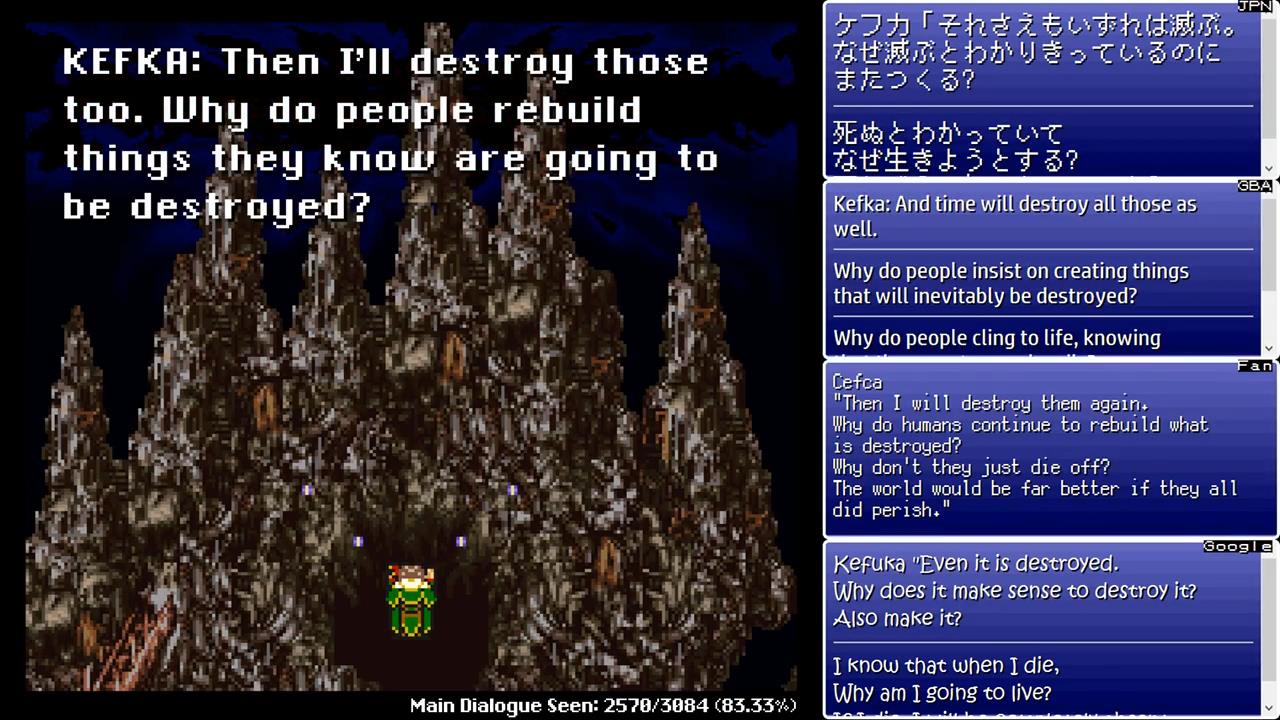
In the original Japanese script, Kefka asks the heroes why people bother to rebuild things despite knowing that everything is fated to be destroyed. It’s a basic philosophical question that feels like a bit of nihilism, fatalism, and/or determinism. Basically, he’s asking “what’s the point of doing anything if none of it is going to matter in the end anyway?”. It’s a surprisingly deep question that lends some insight into Kefka’s worldview.
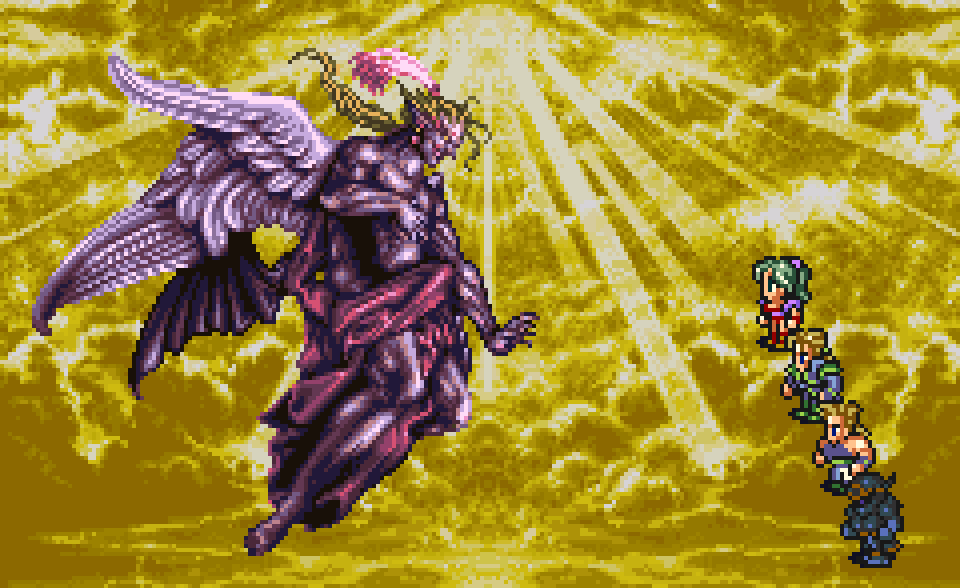
In any case, some of Kefka’s Japanese lines are genuinely thought-provoking. The Super NES translation more or less has Kefka saying “Wargh! I’m evil! I’m gonna destroy all your stuff so I dunno why you’d want to rebuild it!”.
The GBA translator recognized this clear misunderstanding and translated Kefka’s speech to properly reflect the original Japanese script.
Meanwhile, the fan translation makes the same mistake as the Super NES translation and misses the point. It also mistranslates some of the text in a way that ups the “I’m Kefka and I’m generically evil and I’m gonna kill everyone” factor. We can also see that the machine translation struggles to understand any of this philosophical talk or the grammar involved.
Locke’s Lesson
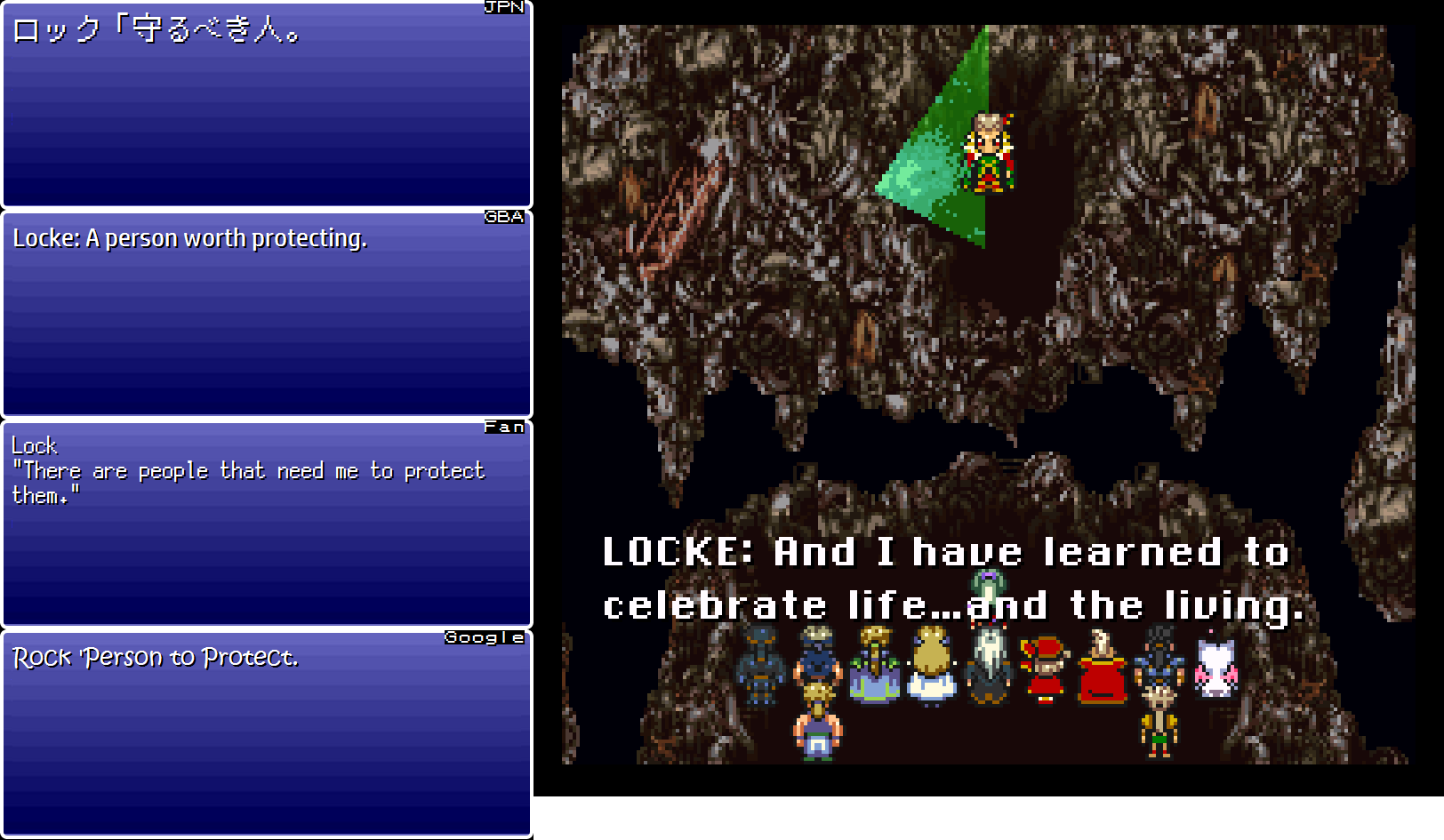
The heroes answer Kefka’s question by stating what gives their lives enough meaning to keep moving forward, despite knowing everything will come to an end someday.
In Locke’s case, he says in Japanese that he’s gained meaning because he has someone to protect – Celes, in other words. This was changed slightly in the Super NES translation to:
And I have learned to celebrate life… and the living.
This does fit Locke’s situation, given that he was obsessed with bringing his dead girlfriend back to life for most of the game. But the phrasing also points a little less directly at Celes and feels a bit more general. It could even be taken to mean that he’s just moved on from obsessing about dead people. The GBA translation changes things back and puts it in line with the original script.
While it’s not completely incorrect, the fan translation goes with “people that need me to protect them”, when it’s most likely just one specific person that is being hinted at.
Kefka’s Self-Help Book
After the heroes share all the things that give their life meaning, Kefka says one of his most famous English lines in the game:
This is sickening… You sound like chapters from a self-help book! Prepare yourselves!

In Japanese, the line is more straightforward and is something roughly like:
You guys and your back-talk… You all make me sick. Ukyaaa!
As we can see, there’s no self-help book stuff at all in the Japanese text. Kefka is sickened by the fact that they dared to back-talk him and give him sass. And his final line is actually just him shouting out in annoyance and not an actual word.
The GBA translator redid this line, but kept the self-help book reference in because it was so iconic and beloved. The GBA version drops the cry of frustrated annoyance, though.
It’s clear that the fan translator took care to stay closer to the original Japanese script here, but it makes some translation and tonal mistakes instead. Meanwhile, the machine translation gets it extremely wrong.
Kefka’s Trick

Shortly after the self-help book line, Kefka prepares to do some magical destruction. But first, he says in Japanese:
Then I will erase those things of yours that give your lives meaning!
The Super NES translator got this line completely wrong and turned it into:
Now, for my next trick, I will make you all…disappear!
So again, instead of referring to abstract things like the meaning of life and the significance of existence, Kefka now just says a generic villain threat. The Super NES line doesn’t even make much sense – Kefka immediately shoots his giant laser beam at empty landmasses below and doesn’t attack the heroes or cities or anyone at all.
The GBA translation fixes this line and gets closer to the original Japanese line:
If that’s how it’s going to be… I’ll snuff them all out! Every last one of your sickening, happy little reasons for living!
The fan translation, as before, treats Kefka like a very generic fanfic villain:
Now I shall kill you all, and bring an end to this nonsense. Say goodbye to your lives!
This line seems like it could’ve been a creative rewrite of the Super NES line. At the very least, it’s not a correct translation of the original text in any way.
Destroying to Create
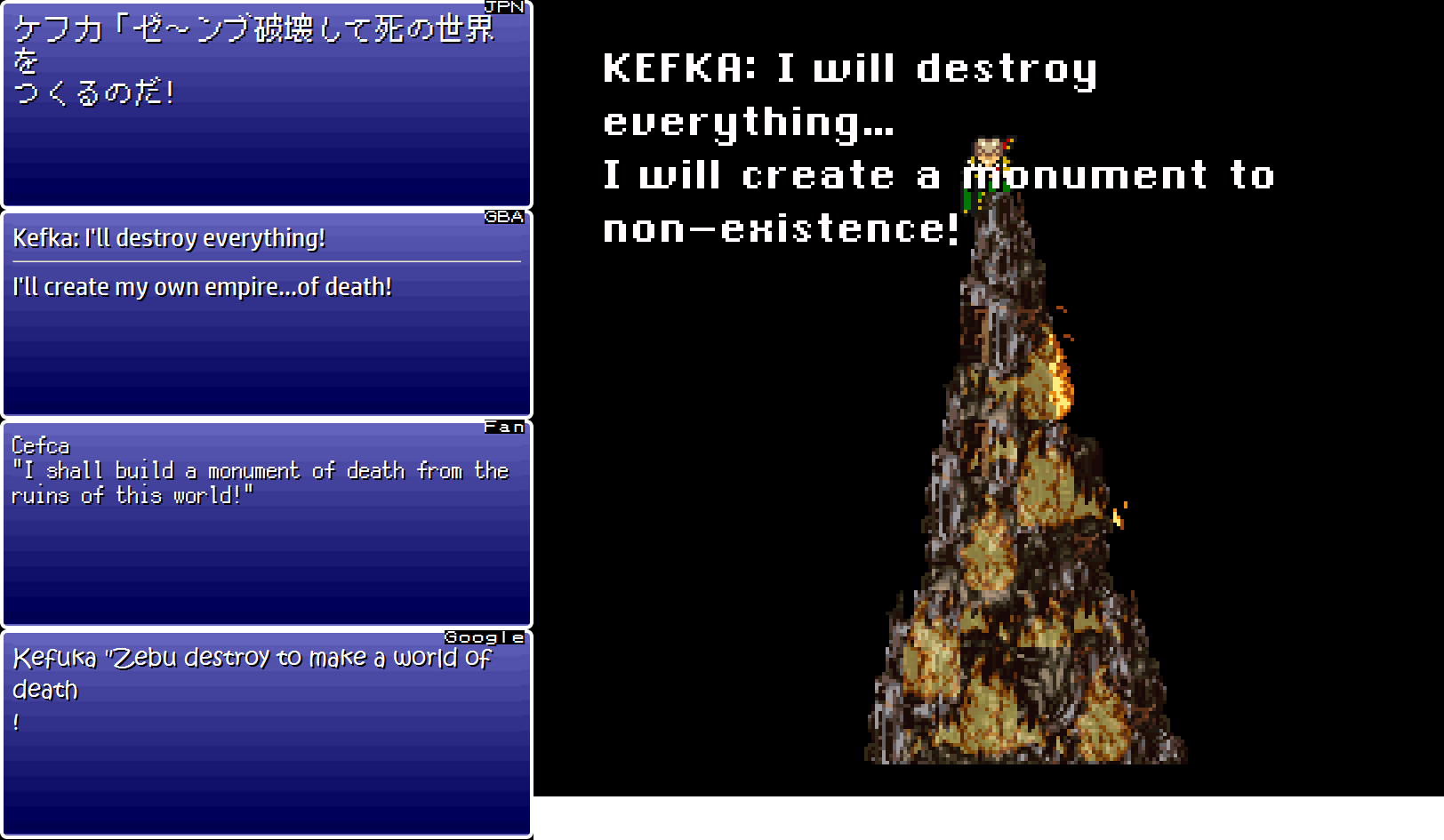
Kefka is really worked up now. He’s tearing his tower apart and rearranging stuff while the heroes stand underneath the shifting, burning ground.
In Japanese, he eventually shouts:
I’m going to destroy EVERYTHING and create a world of death!
I just finished criticizing some of the translations for sounding like generic villain stuff, but now it’s the Japanese script’s turn to sound generic, as we can see. The Super NES translator had to dance around the “death” thing and wound up making something that I think is even better:
I will destroy everything… I will create a monument to non-existence!
In my opinion, that actually sounds cooler and ironically fits with the original script’s philosophical questions about existence better than the Japanese version of this line. Plus the contradiction introduced by this new line adds a nice touch.
Of course, there’s a common question that translators have argued over for centuries: does the translator have the right – or imperative – to improve on the original text? I don’t think that’s something that anyone will ever agree on, but I feel this is a good little example that non-translators can chew on. Personally, I feel it almost always depends on the purpose of the translation and the intended target audience.
Anyway, I’m guessing the GBA translator pondered this same question many times throughout the GBA translation project, and possibly even during this line. In the end, this line was changed back to something closer to the original:
I’ll destroy everything! I’ll create my own empire… of death!
The fan translation seems to be an interesting hybrid of the Super NES line, the original line, and some added flair. The machine translation kind of barfs on this line because of the way Kefka emphasizes the first word in the sentence.
Maduin’s Message
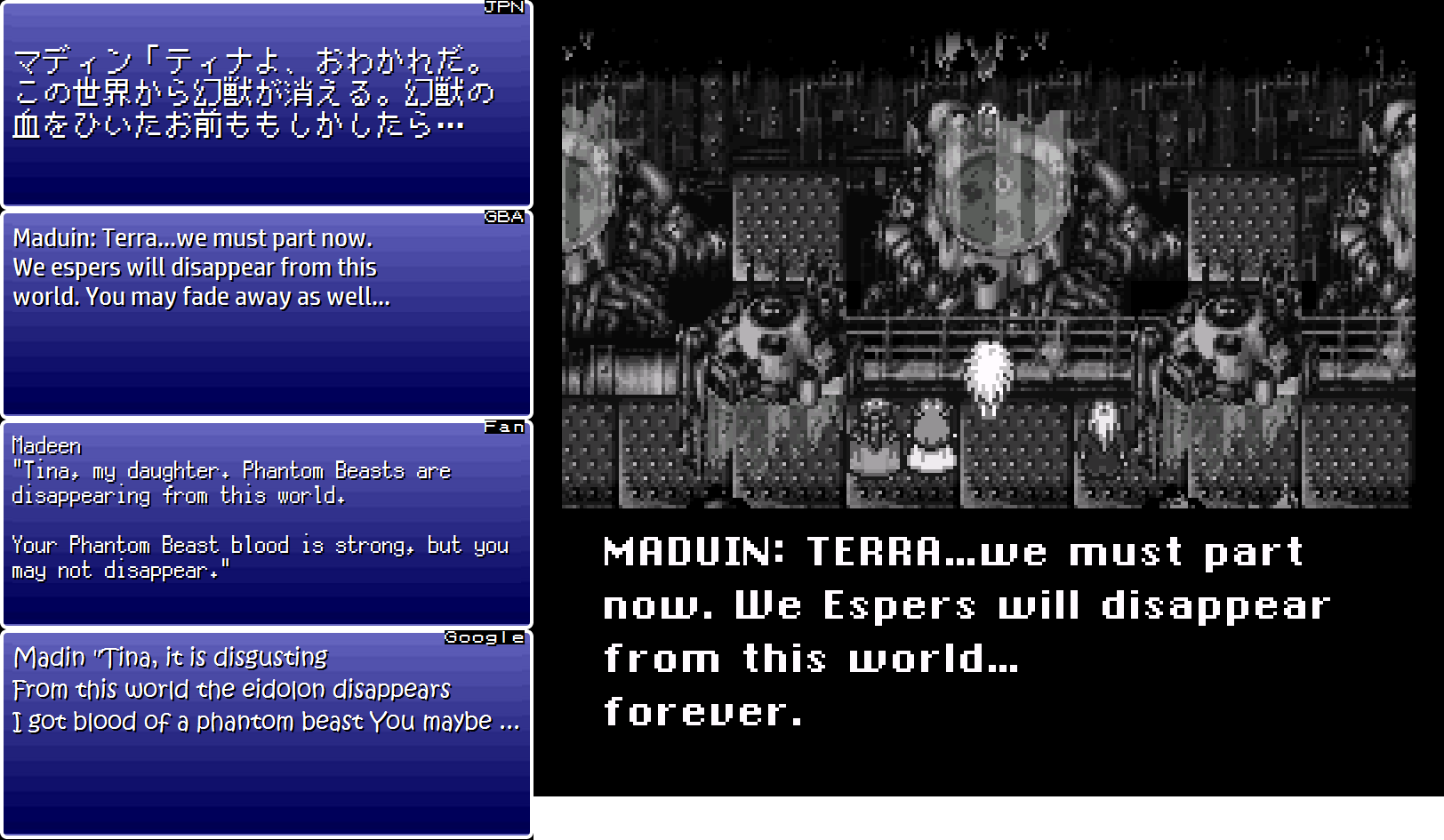
After Kefka is defeated, the tower begans to fall apart and magic begins to disappear from the world, including the Espers. Maduin gives Terra one final message. In Japanese, it’s something like:
Tina. This is where we say goodbye. The Espers will disappear from the world. You have Esper blood in you, so it’s possible that you, too, will…
The sentence is left incomplete in Japanese, which is pretty normal. But basically, he’s saying that there’s a chance that Terra will disappear or be affected in some way too, since she’s part Esper. Man, it’d be horrific if only random pieces of her suddenly disappeared, now that I think about it.
The Super NES translation cuts out that final sentence and its potential consequences:
Terra…we must part now. We Espers will disappear from this world… forever.
Still, it’s not a huge deal, because the following lines explain how there’s a chance her human emotions could be strong enough to keep her from disappearing.
We can see that the GBA translator restored the missing line. But what stands out to me most is the fan translation, which says:
Your Phantom Beast blood is strong, but you may not disappear.
That’s actually the opposite of what Maduin is suggesting might happen. There’s also nothing about “strong” in the original text, and since the following line begins with a “but” or “even so”, it feels to me that the translator didn’t fully understand the grammar or wasn’t used to handling incomplete sentences in translation like this.
Shadow’s End
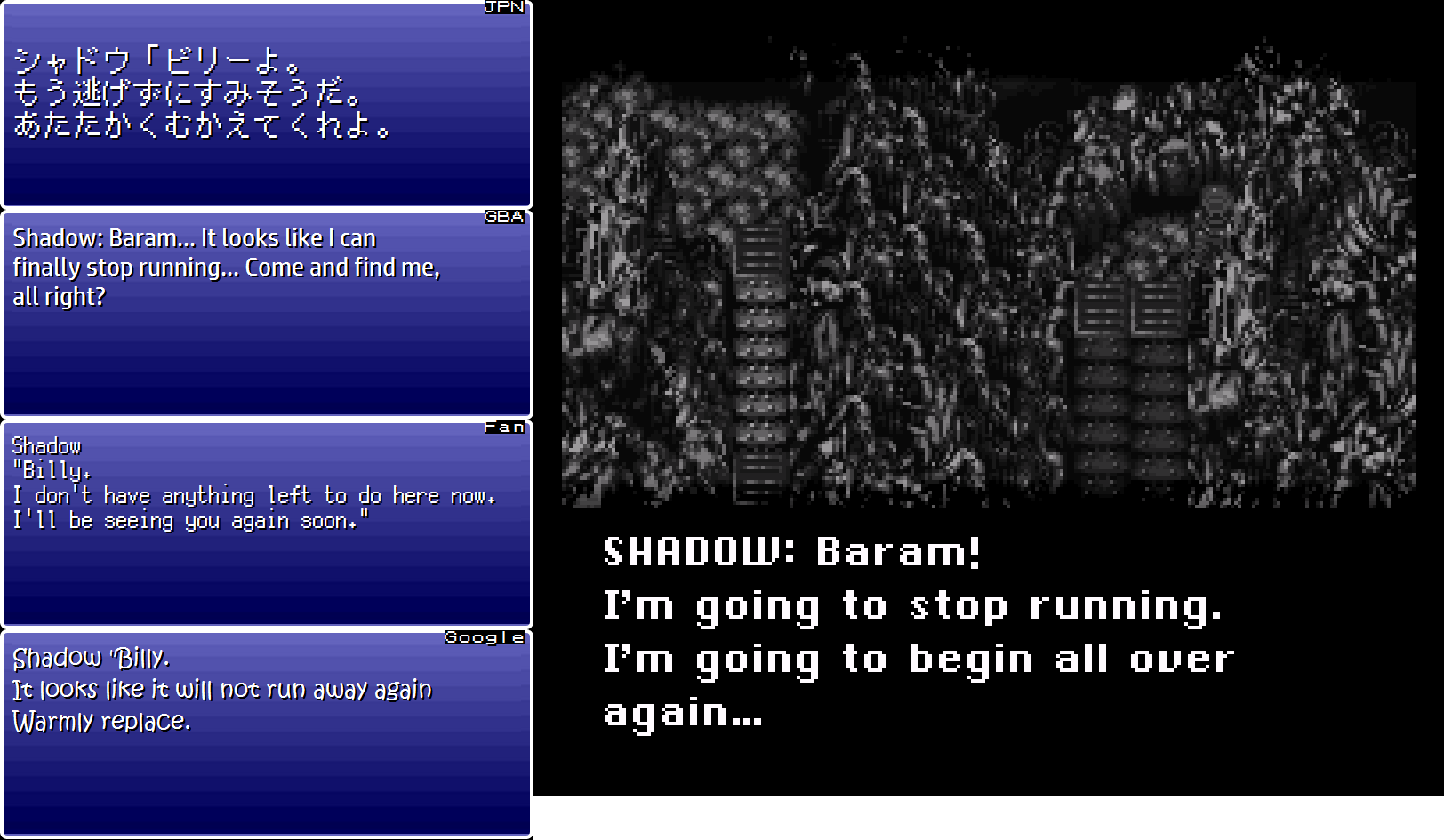
Previously, we’ve seen how Shadow apparently killed his old partner Billy/Baram, or at least somehow caused his death. That whole back story was mishandled in the Super NES translation, so it’s not surprising to see that Shadow’s final scene during the game’s ending has some similar issues.
In Japanese, Shadow says:
Billy. It looks like I can quit running now. Greet me warmly.
The implication is that he’s finally finished up whatever remaining business he had and is ready to die. So he decides to stay in the tower as it collapses.
The Super NES translation changes things slightly:
Baram! I’m going to stop running. I’m going to begin all over again…
I’ve heard different fan interpretations of this text, but I’m not really sure what the consensus is. I think many gamers could read through the lines and tell that he was ready to end his life, but that last English sentence could also be interpreted as Shadow deciding to stop running from his past and start a new life free of robbing and killing. Even so, that doesn’t really fit with what happens on-screen, so maybe this was another case of the translator trying to avoid Nintendo’s content restrictions.
The GBA translation changes the line closer to the original Japanese text. The fan translation rewrites the entire line and outright states the interpretation in my previous paragraph:
Billy. I don’t have anything left to do here now. I’ll be seeing you again soon.
The original Japanese line isn’t that blunt, but I guess the fan translator really wanted to address this line and stamp out any fan uncertainties and theories.
Terra’s Encouragement
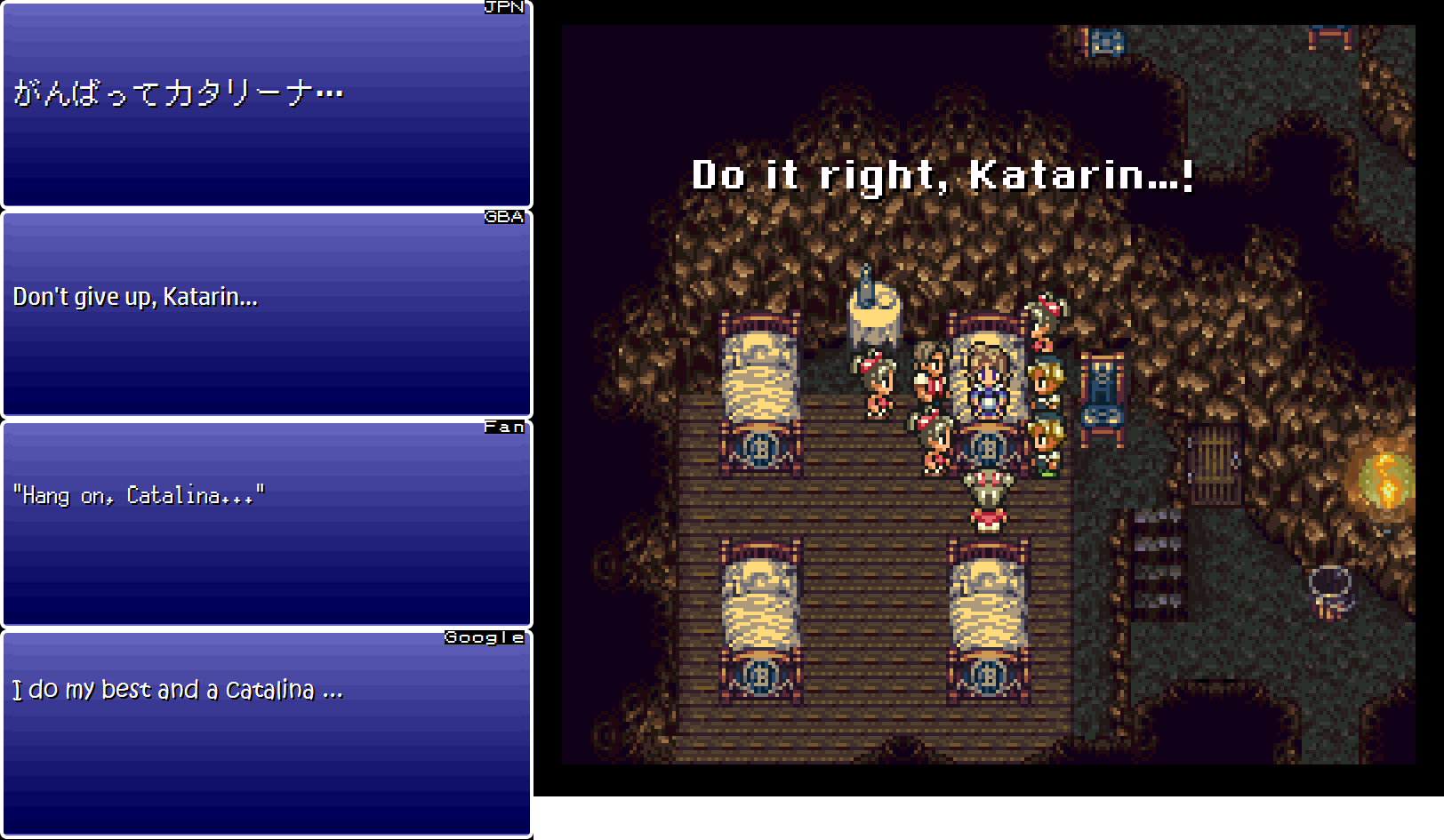
As the ending comes to a close, Terra says that she’s going to try her best to make it in this new world. Then she tells Catalina/Katarin – who’s about to give birth in this new world – that she should also do the same.
In the Super NES translation, this line of encouragement was worded as “Do it right, Katarin…!” which doesn’t quite fit the intended tone. It could even be interpreted as “Give birth right, Katarin!”, but I think most players understand what’s trying to be conveyed.
The GBA translator fixed this line to match the original text more closely.
The fan translation says, “Hang on, Catalina…” but that doesn’t really make sense in this context. I guess it could be considered encouragement, but it strikes me more as a “Hang on, I’m coming to help you out, Catalina!” type of line, which wasn’t the original line’s intention.
All in all, this is just a minor quibble that I probably wouldn’t normally have pointed out, but since it’s one of the very last lines of text in the game, I figured it’s worth a quick mention here.
The End
Whoa, we did it! We got through five versions of Final Fantasy VI all at once!
If you managed to read this entire comparison from start to finish, you deserve a gold medal. I wonder how big this would’ve been in book form.



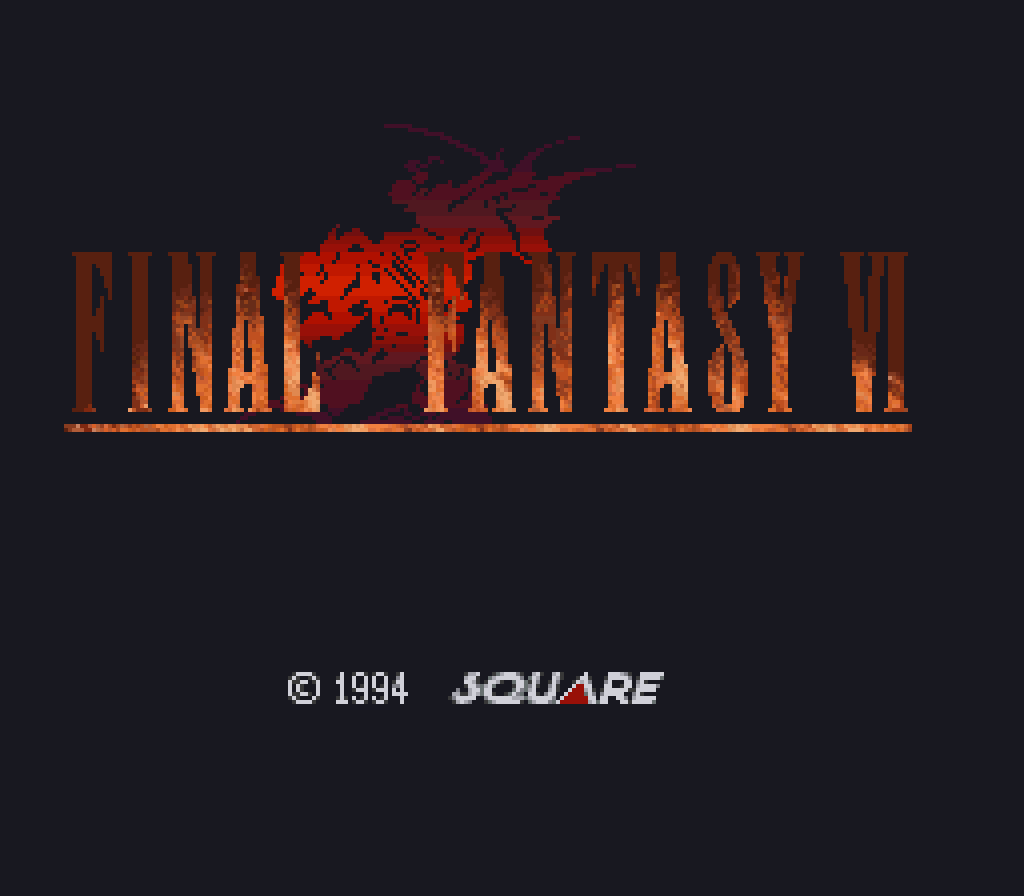
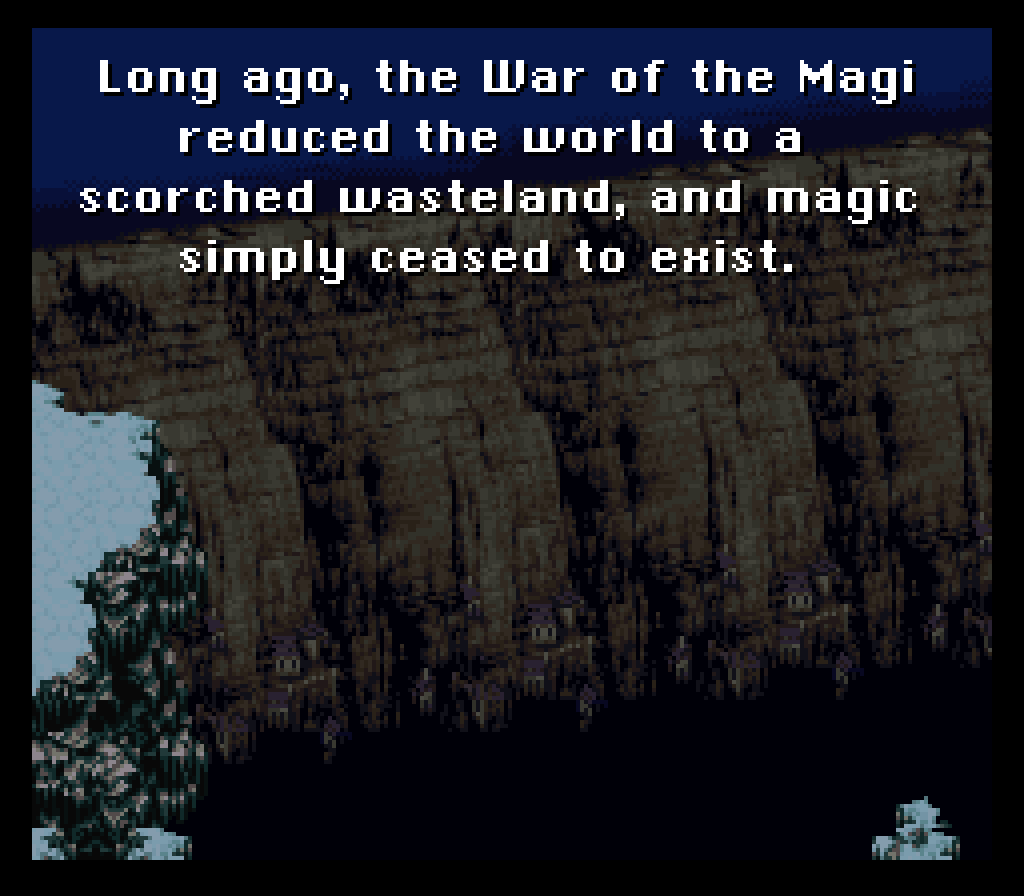

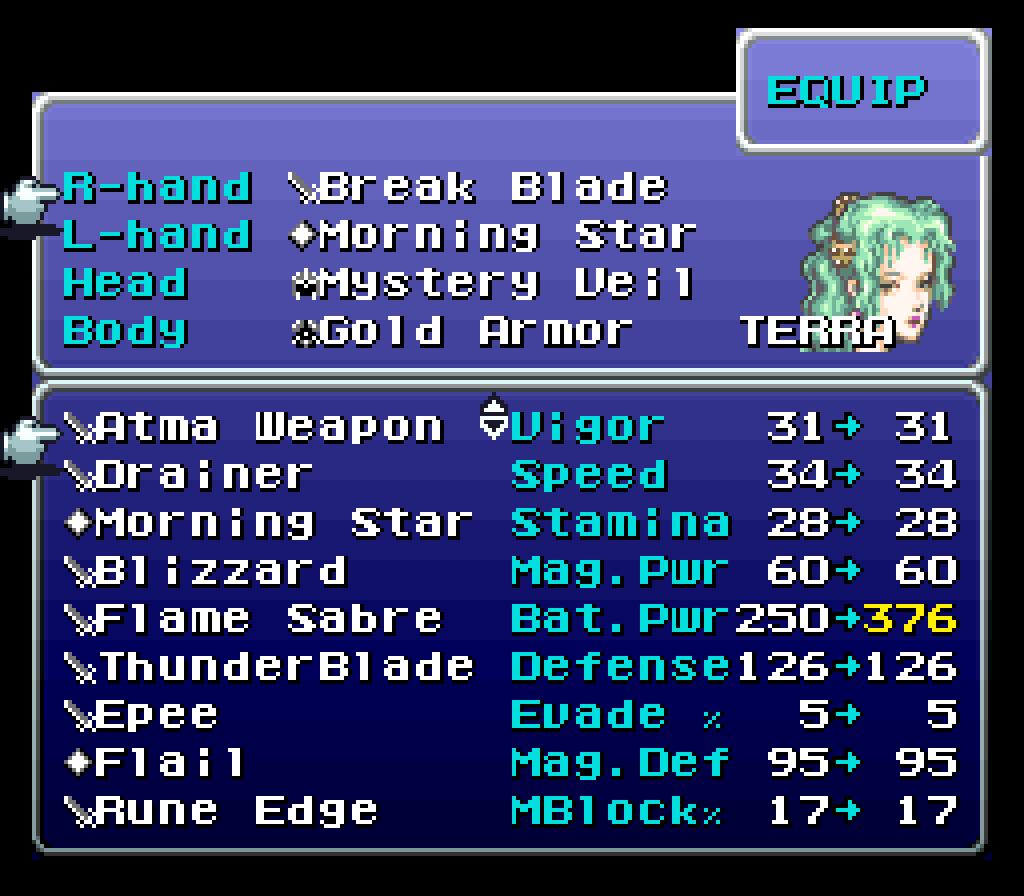
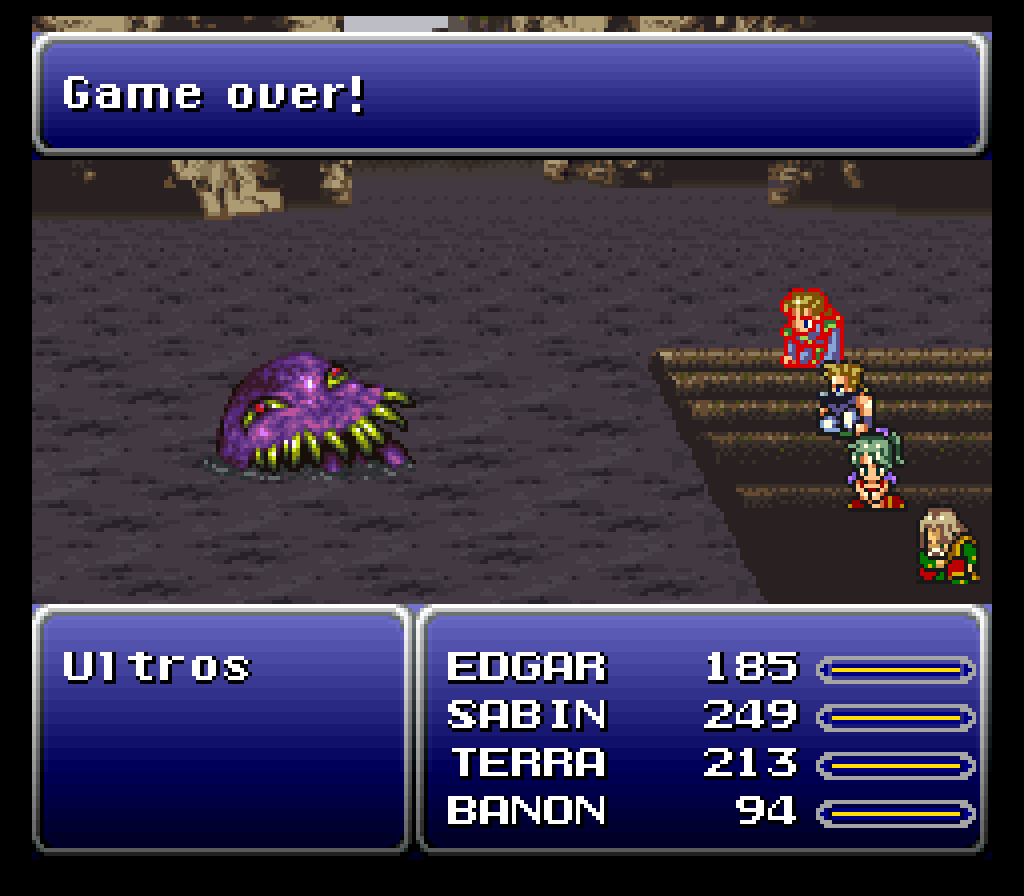
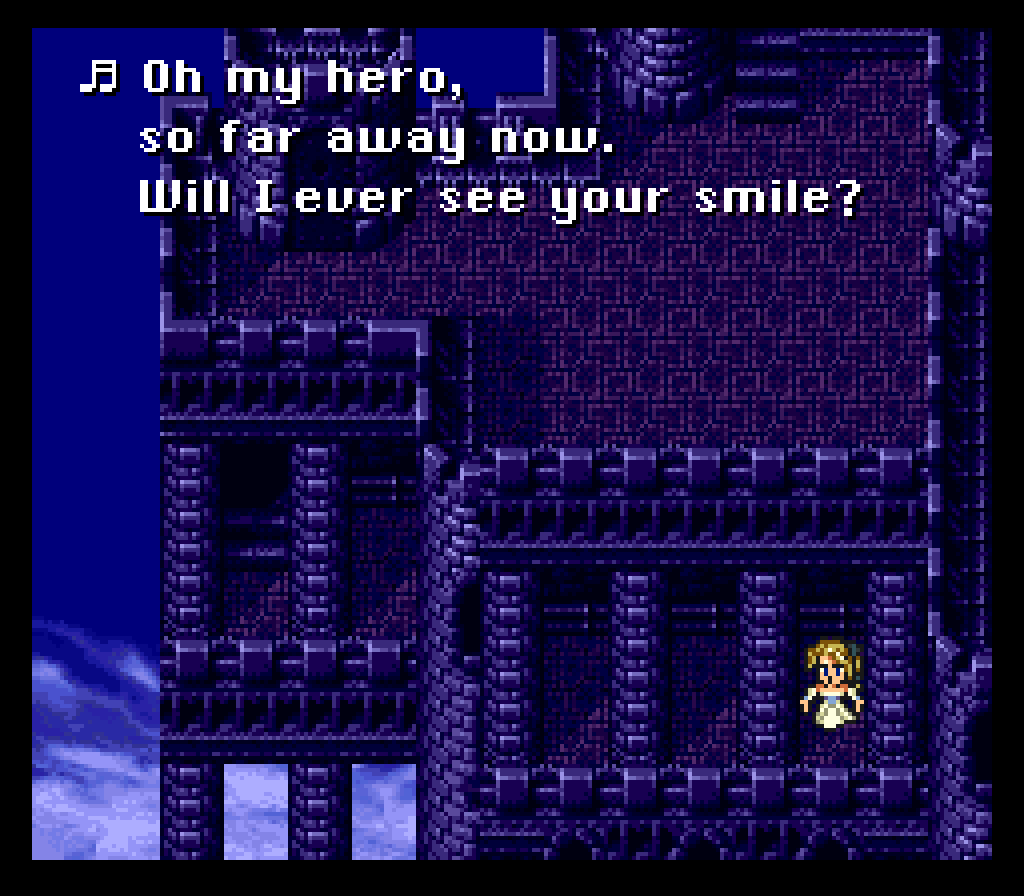
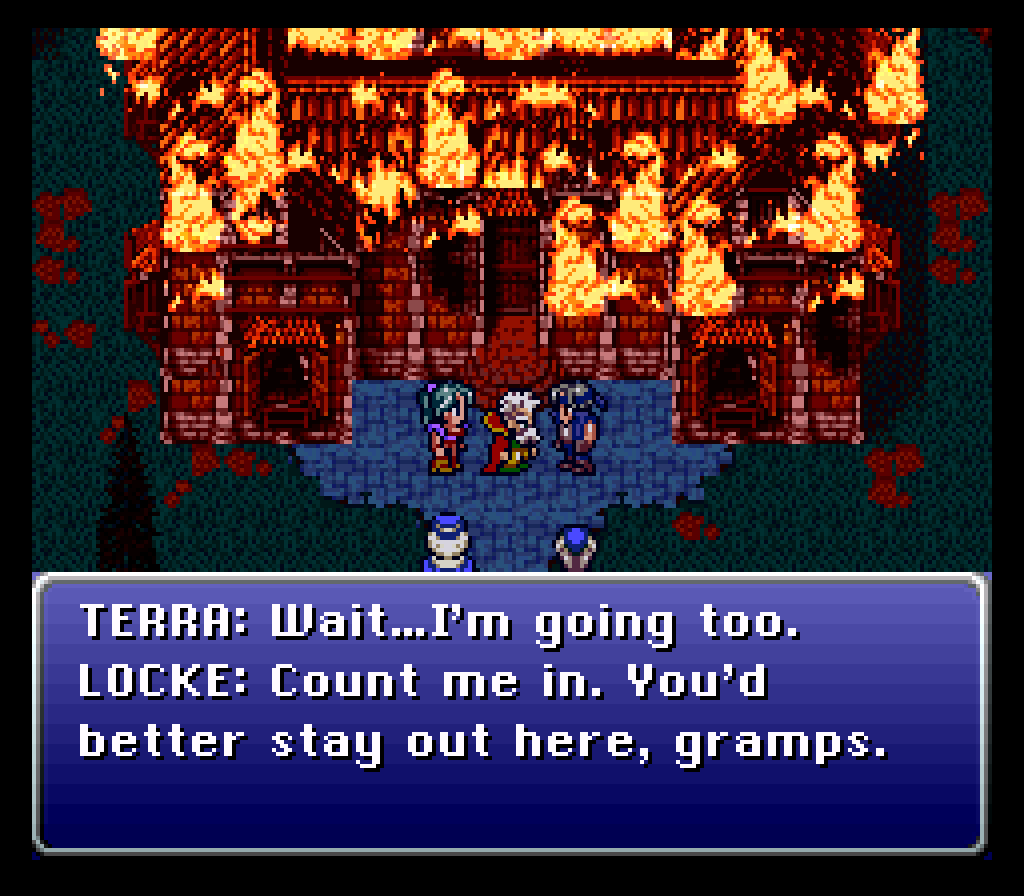

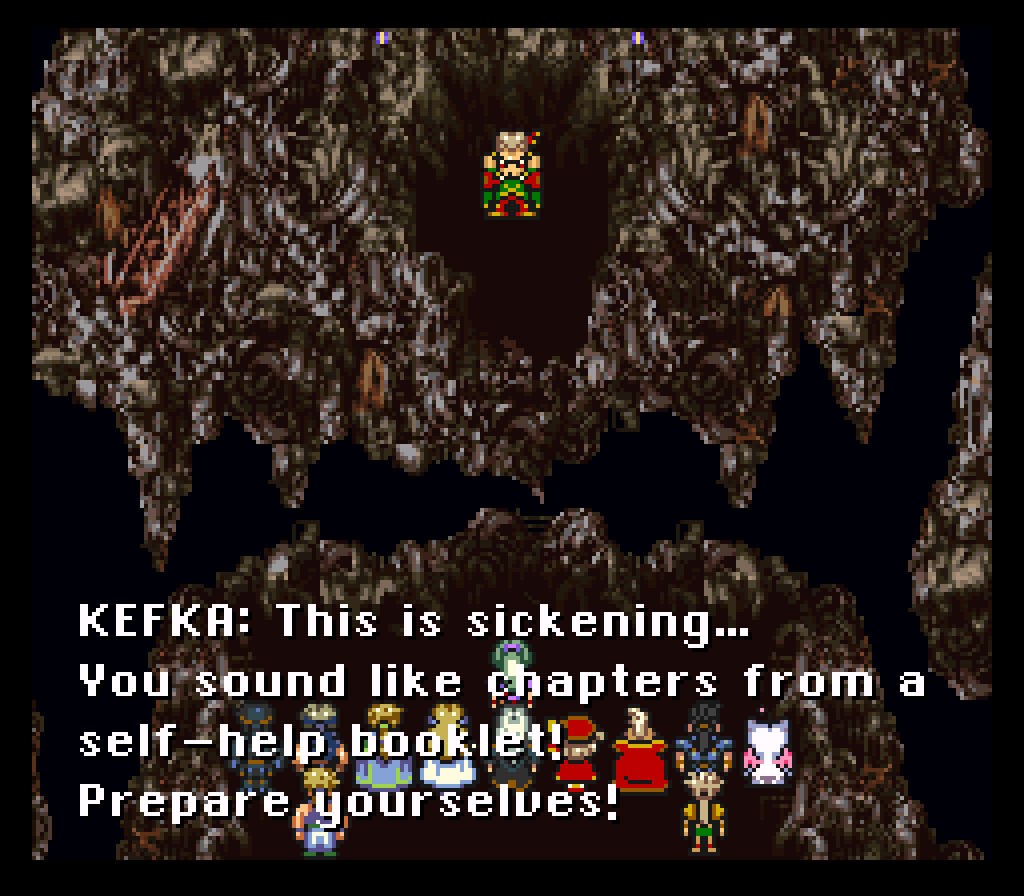
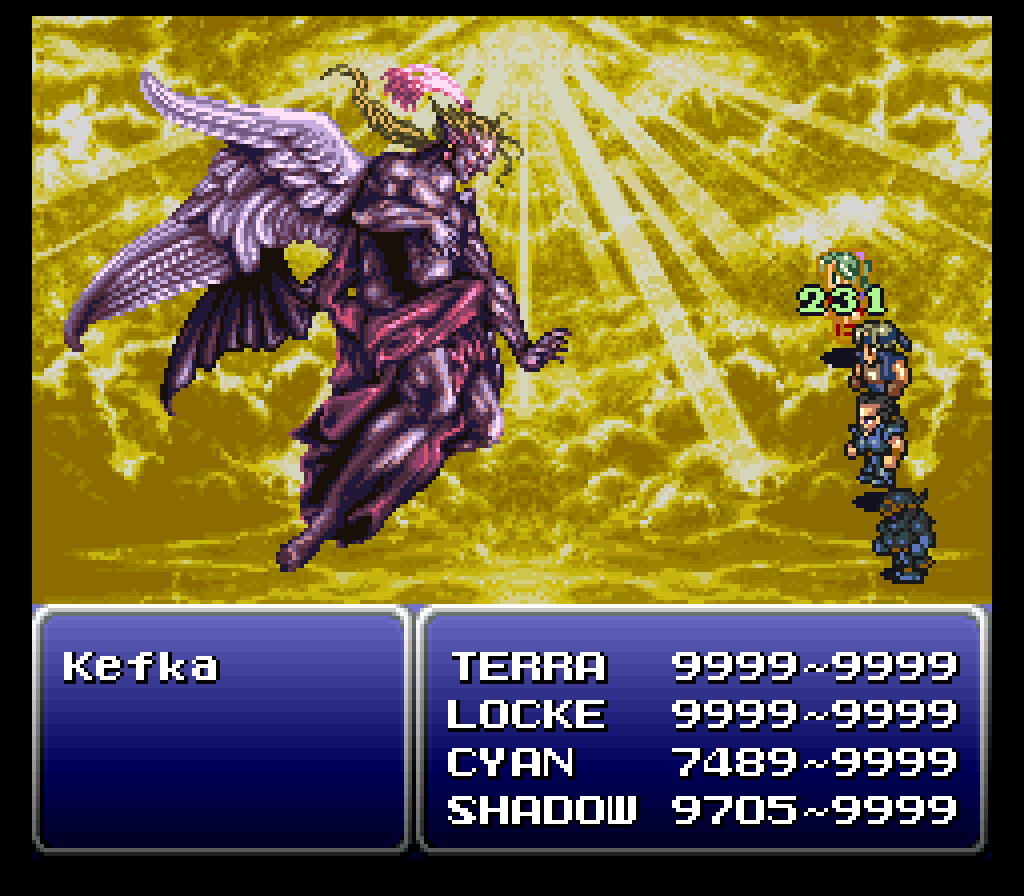
![press start to translate [Final Fantasy IV] press start to translate [Final Fantasy IV]](https://legendsoflocalization.com/wp-content/uploads/2019/08/bbenma.png)
The only time I can recall seeing 鬼神 outside of FF VI is in Majora’s Mask. The 鬼神の仮面 was translated as “Fierce Diety’s Mask” in English.
Nice set of articles. I’ve played this game in Japanese a couple of times, but I still learned some new things. Thanks for writing them.
That version of Majin is also used in the title of Mashin Hero Wataru (魔神英雄伝ワタル).
I have the entire first series release for that. It had terrible English subtitles, but it was an import after all. Zany and wacky as hell anime though. XD
One very common usage is in nearly every single Tales of- game. The attack “Demon Fang” is 魔神剣, or ‘Majinken’. In Legendia it’s written with the Kanji for fist instead of sword (as the hero is a fist-fighter), but they have the same reading.
Glad to see this posted; I’ve checked every day, since Part 13 was uploaded, waiting for this! Thank you, Clyde!
“Kishin” appear in the title of the manga and anime “Kishin Douji Zenki”, which has spawned a few video games, some of which have been fan-translated. The recent cccmar translation of the Game Gear game translated the title as “Demon Child Zenki”, as Dynamic Designs had done a few years ago with the first SNES game (maybe for consistency?) The licensed English anime kept it simple by just renaming it “Zenki”. The abandoned manga scanlation kept the title and mostly just referred to the character as a “demon”, though it kept the word “kishin” on the first page (“in this world, there exists beings called “kishin”).
One neat thing I see here and elsewhere in Japanese entertainment is the repetition of a kanji suffix to indicate that a list of people or things are all part of a group that shares some quality. The names 魔神, 鬼神, and 女神 indicate pretty clearly (at least when written) that these three critters are part of a trinity of gods (神s), each of which is a god in some specific way. And it seems like it’s really tough to keep that association between the names in English without making it sound forced; even the GBA doesn’t really bother attempting it. Trying to capture the literal meaning of the kanji would just be something like “Dark God,” “Angry God” and… “Girl God,” I guess. It wouldn’t be too bad, if it weren’t for English being so weird with gender.
Maybe a translator could use something like “Blue God,” “Red God” and “Golden God”? It captures the essence of each one fairly well, while keeping it clear that they go together like crayons in a box.
But the game doesn’t use kanji there, and the words use different readings, so めがみ doesn’t appear to have anything to do with きしん or まじん. All three read the 神 character differently.
On a side note I wonder why they’re all in hiragana. Aren’t character and enemy names usually katakana in this game and series?
“Megami” is native Japanese, while “kishin” and “majin” are Sino-Japanese. Could that be why the game uses hiragana?
A valid point; I don’t know how readily a native speaker would associate the word with the kanji and see the visual alliteration.
These are all Japanese (or at least Chinese-derived Japanese) words, and words with a meaning in Japanese are usually written in hiragana if they need to be spelled out. Katakana is used for words that are written phonetically, like foreign words or sound effects. Most of the names of things in RPGs are fantasy names that are written phonetically in katakana, but in this case they’re just Japanese words.
I agree with what you said initially. These are real words, the player can know how they’re written independent of the game. It’s a cool little touch that draws attention to A) how the gods are all the same type of thing, but very different individuals and B) how alien they are, how we can’t really call them by name so much as slap a description on em.
Actually i had the same idea– mine was “Cruel God,” “Wild God,” “Loving God,” which sort of ratifies the sexism but is a good reference to how she makes your characters fight for her. Or God-Devil, God-Animal, and God-Queen maybe. Or even Demon, Titan, Goddess if it looks better snappy than parallel. But the key idea seems to be that Majin is absolutely hostile and anti-human, Kishin is a wild force of nature that doesn’t care about you either way, and Megami is the kind of god that you want to serve and identify with. They run parallel to the three kinds of magic, too.
And Mato thanks for doing all this so we can armchair quarterback it in this particular way, haha
All the names in the enemy name menu use hiragana and katakana, which is why 魔神 appears as まじん in the screenshot in the article. But it’s written in kanji as 魔神 when it’s referred to in the battle message text window at the top of the screen sometimes.
I think I killed the other bosses too fast to see if their names also appear outside of the enemy name box but I assume they’d follow the same pattern if so.
Shin Megami uses Kishin as the name of demon race. The Four Devas/Heavenly Kings almost always belong to it, and for some reason Thor often does too.
Kishin is also the name of the Hyper Mode X Deathblow of the Weltall in Xenogears, its strongest Deathblow.
I recall hearing Kishin was used in a skill name for Fire Emblem Heroes, what it was translated into I do not recall however. It might have been one of the skills with a bird in its English name, maybe Swift Sparrow?
Kishin is the name in Japanese of one of the two giants in Xenoblade Chronicles takes place on. However, the first character is different, and apparently means “machine”, thus the English name being (a more creative) “Mechonis”. Though if it is pronounced the exact same, I could see in Japan them being able to take advantage of the homophonic word play. The game’s opening sequence tells and shows of how the Mechonis and the Bionis (Kyoshin- “Giant God”) fought each other to a draw, which sounds quite fierce.
To speak of FFVI’s finale here, the “monument to nonexistence” line, I’m not sure whether that is too philosophical for Kefka. I mean death is nonexistence, and while Kefka is going nihilistic, do they actually want a perfectly still, nonexistent world? Sounds a little too boring for them. I think Kefka wants to be entertained, and in destruction they can find a little fun to ease their boredom it seems. To create a world of death and suffering, with of enlivening screams and violent action that might be want to takes to alleviate this joker god’s ennui. This is just my interpretation of Kefka though.
I do like the self-help book toss in, even if it seems a little out of place since who’d have thought FFVI’s world to have those things? But I wonder if there was something lost in removing the “don’t talk back to me!” part of the line. Do we need to be directly told Kefka doesn’t like backtalk this late into the game? We’ve already seen plenty of instances where they don’t, and as it is apparent in the scene Kefka is being pretty frustrated with the heroes, one would conclude without having it said that Kefka doesn’t like criticism. But something in me is saying it’s wrong to leave it out, even if it isn’t subtle or new. More or less? This sounds like it could be a normal translator’s dilemma.
As for the Warring Triad brought to life, there are things I like in their names, and things I don’t.
What I like is how the names are kept as single, generic words. In a way, it makes them feel fundamental, primordial, transcendent- almighty beings that first arose in the universe (not that they actually did) and define what it essentially is, to put it poetically. All who claim to be goddesses are to be measured against the Goddess as to determine whether they are one or not, since the Goddess is even more than tautologically a goddess. To use a similar case, apparently, the final boss of SMT: Strange Journey uses some spells that are simply called things like “Fire”, “Ice”, “Light”, as a way of indicating they are in their pure, original and powerful forms.
What I don’t like are the choices of Fiend and Demon, they sound too similar and easy to confuse. I can always recall which is the Goddess, but the other two I can mix up. Changing Demon to “Deity” would possibly be able to fix this, yet it wouldn’t really work, since like the Fiend, the Demon looks evil, and Deity has more of a neutral tone. Maybe it would’ve been better had they designed the Demon differently, to be something between the dark Fiend and holy Goddess, but it’s several decades too late for this. Maybe the Classical Greek “Daemon/Daimon” would work? Since according to Wikipedia, they were either benevolent or benign, and the ai/added e would for me make it distinct enough from Demon and thus from Fiend. Not that this fixes the issue of appearances.
The fan translation approach does fix the Fiend-Demon issue I speak of, since Majin and Kishin look nothing alike. However, by keeping the names of these beings out of English, it removes that primordial transcendence I like in it. Anyone who speaks English knows what Goddess means and that it’s typically a common noun. Nobody knows what a Megami is, and the word becomes rarefied and complex to the non-informed, when in truth the word is very simple. And you can’t splice the Warring Triad between 1 translated and 2 untranslated names, that’d look weird.
You’re right about Swift Sparrow in Fire Emblem Heroes including Kishin in its name in Japanese! More specifically, the skill Death Blow is called Kishin no Ichigeki (鬼神の一撃) – it’s one of a set of skills that each grant bonuses to a certain stat. There’s also a set of skills that grant the same type of bonus, but to two stats, and their Japanese names combine the names of the two single-stat skills they match. So Swift Sparrow is 鬼神飛燕の一撃, Sturdy Blow is 鬼神金剛の一撃, and Mirror Strike is 鬼神明鏡の一撃.
(Darting Blow and its siblings were actually introduced in Fates, I believe, but the combo skills are Heroes-exclusive.)
I really like both the SNES lines here. “Monument to non-existence” sounds like a way scarier and more concrete version of the original line; there are some sort of limits to his power, but he can wreck this whole world, leave it as a cosmic graveyard to express his feelings about existence. “Self-help booklet” sounds ultra contemptuous, which i think is the nuance of the original– he wasn’t even listening, just letting all the heroes play out their line emotionally before he smacks them down.
But also I found this comment interesting because it brings up the issue of how the translator understands the character, not just the line. Why are they saying that when they’re saying it, what do they want the listener to get out of it? I gotta say I disagree with yours; I think the context makes it clear that Kefka has been straining at the limits of the pleasure of cruelty, and that’s got him thinking about larger questions. He’s already got the world you’re describing and it’s starting to bore him; he actually has had to chill on the random devastation a little, just so he doesn’t run out of living things to victimize.
I like the “monument to nonexistence” line in combination with “the end comes… beyond chaos”, but I can see where you’re coming from with your perspective.
My read on it is to see the “ruin” half of FF6 not just as “Square JRPG, but the heroes lost” (which I think is almost taken for granted nowadays when looking at the story) but as an exploration of what it looks like when the “bad guy behind the bad guy”, the depraved-beyond-even-self-interest ultra-villain who tends to lurk behind the early-series FF games until the very end, not only wins, but also happens to be the simpler, pettier henchman of the more mundane, greedy, world-conquering type who’s the villain for a good chunk of those sorts of early-FF stories.
To draw some analogies that apply within certain limits, Kefka is both, say, Heidegger and Sephiroth to Gestahl’s Rufus, or both Cagnazzo and Zemus to Gestahl’s Golbez. What we see in the “World of Ruin” is when the villain who chooses annihilation over conquest wins. But he’s also just a man, and a compulsive and a sadistic one, and his death drive and urge to share it is motivated not by how great and terrible Kefka is but by how small and unimaginative he is.
Now that he commands god-like power, Kefka’s slowly killing everything that’s still clinging to life after the misaligned Triad broke the world, but “slow” in this case is, oh, maybe another year or so before he’s chewed through every living thing on the planet. Still, it’s longer than it should take, if that makes sense, and at the point when Celes sets out to find the rest of the Returners, Kefka’s major roadblock seems to be… Kefka. The physical seat of Kefka’s god-like power is a jumbled pile of nonsense built in the dead center of hubris country. Kefka’s plan to destroy everything seems like it’s revved up and stalled out over and over on his own say-so, with major structures still standing, like he’s saving them for dessert. Or maybe he just got distracted sticking it to Tzen over and over, because it’s fun. And so on.
Kefka by the end of FF6 seems to be a character in conflict, but he’s not nearly self-aware enough to understand the conflict exists, and the true end, the end of the end, will arrive when that conflict resolves itself.
The petty bully in Kefka, the guy we see forcing his soldiers to dust his boots as he marches through a sandy desert, becomes the part that has him carving up towns with a few seconds’ flash of his death ray as soon as they start to rebuild—fun, but dreadfully inefficient. That part of him is arrayed against the other side of him: the man-turned-annihilator roughly equivalent to EXDeath or the like, the Kefka who would destroy everything the other Kefka would prefer to torture forever. The side that answers only to the void is the one we see slowly emerge throughout the “Balance” half of the game, until Kefka finally commands the power of the Triad, and instead of using them to conquer the world, he uses them to first shoot his boss point-blank, then shoves them out of alignment, more or less because it seems like the worst possible idea at the time.
That’s the horrible contradiction we see in Kefka at the end according to the English script: a character whose brutal, lazy sadism has been the only thing standing between all life and eternal nothingness, whose servant he is as well. I think both the SNES and GBA scripts for the final confrontation do a very good job of showing a villain who’s not just “movie-crazy” sadistic, but whose sadistic villainy is roiling and cracking like a layer of barely-cooled basalt roiling over an imminent volcanic eruption: cracks about self-help booklets boil over into monuments to nonexistence. Petty chaos gives way in the final minutes to Chaos, the void before existence.
As already mentioned, Kishin is used in the Shin Megami Tensei games. Most of the time it’s left as-is to maintain consistency across games starting with SMT Nocturne (which was the first time the mainline nomenclature was localized into English, so most follow that game’s examples with such terms–even though some of them are questionable, such as how “地霊” gets transliterated to the opaque “Jirae”).
SMT IMAGINE, however, translated Kishin as Guardian–which as far as I’m aware of the term, is a pretty solid translation choice.
As for Kefka’s philosophical turn, my take has always been that he’s come to realize that despite his godlike power, he’s still a mortal man susceptible to injury and death. He’s obtained the ultimate power, but he’s going to die anyway–something he’s projecting onto the rest of the world.
It’s a solid choice, but Guardian still doesn’t convey the whole angry/fierce/wrathful theme that Kishin does. Megami Tensei’s Kishin Thor art comes first to mind when I think of this hair-splitting. After all, he looks more like a Kishin than a Guardian, that’s for sure.
Alas, the limits of the English language seem to provide no better word though.
You say that like it’s the English language’s fault. The Japanese just can’t come up with one word for everything. There has to be multiple definitions for so many words like majin and kishin.
Not only is Atma/Ultima Buster stuck in a jail cell, but the toilet stops working after World of Balance. I guess totalitarian destructionism doesn’t pay for the infrastructure.
Regarding jihad, a possible vector for common Western knowledge of the word would have been the group named Palestinian Islamic Jihad, with an attack on an Israeli bus in 1989 being the group’s most famous event up until this game’s release. The word would probably be otherwise familiar to anyone with an interest in Middle Eastern current events at the time. The spelling may not have been consistent. For example “gihad”, “jehad”, and “djihad” saw some use, similar to Koran/Quaran, Mohammed/Muhammad, Osama/Usama, and Qatar/Katar.
Funny how “god” is forbidden but “goddess” is fine. Sexism!
Isn’t it the same cell that Kefka was imprisoned in at the end of WoB, by the way?
You know, now that you mention it… That comment combined with Tomato’s pondering over how long it’s been there has me wondering if maybe Kefka created Atma himself simply to be a dick and lock it up
https://en.wikipedia.org/wiki/Fierce_deities
Apparently 鬼神 is the Japanese term for a kind of being in Buddhist myth. Something to keep in mind, I think.
With the parallels between Buddhism and Gnosticism, I think that makes the Kishin wordplay in Xenoblade very appropriate.
Did not mean to sign with two different names, whoops. Sean Fearnley and Angelo are both me.
These seem to be called 忿怒尊 (funnuson) in Japanese. Where are you getting the kishin connection from?
There’s the anime ‘機神咆吼デモンベイン/Kishin Houkou Demonbane’ which seems to have dropped the kishin part entirely and just been called ‘Demonbane’ in the west.
in the manga/anime Soul Eater, there’s beings just straight-up called Kishin, and one of the main antagonists, Asura, uses the same word as an alias. The dub of the anime changed it to Afreet. Not sure what the manga translators went with.
Being a nerd of the 90s, my primary association with Kishin is Kishin Corps, which is written as 機神兵団 so it’s clearly not the same version of “Kishin” as this.
“The fan translation says, “Hang on, Catalina…” but that doesn’t really make sense in this context. I guess it could be considered encouragement, but it strikes me more as a “Hang on, I’m coming to help you out, Catalina!” type of line, which wasn’t the original line’s intention.”
This doesn’t strike me as TOO far off, unlike a lot of the fantranslation. Birthing, especially before modern painkillers, is exceptionally painful (hence the screaming) with a high mortality rate.
In the anime Soul Eater, the race of humans – turned – evil is called 鬼神、 and the Funimation dub ran with the translation ‘afreet’, which is an alternate spelling of Ifrit ie an evil djinn.
Yep! I remember this because it was around the time I took over as the show’s translator and remember thinking “well, that’s an interesting choice”.
Reading this article, I was reminded of FFIX somewhat. Y’see, the powerful Doomsday spell in that game was Jihad in original Japanese as well, not to mention the trio of statues found within the Desert Palace modeled after the Warring Triad. Speaking of FFIX even further, some of the things that might seem like mistranslations actually aren’t as they actually were that way in the original Japanese too, including Limit Glove and Valia Pira. That said, it’s true some of the things might have been lost along the way which is why I wonder if you’re gonna do FFIX articles at some point…
“The GBA translator redid this line, but kept the self-help book reference in because it was so iconic and beloved. The GBA version drops the cry of frustrated annoyance, though.”
It’s still in there, just moved to the beginning of the sentence instead of the end.
An interesting note on the Three Fiends is that they were later included in the MMO FFXIV as primal with actual names, and their original FF6 names as titles.
魔神 became “Sephirot, the Fiend”
鬼神 became “Zurvan, the Demon”
女神 became “Sophia, the Goddess”
According to the FF Wikia these names were taken from the original concept art (which was included in the Memorial Ultimania).
Concept Art Here:
Sophia: https://vignette.wikia.nocookie.net/finalfantasy/images/9/98/Goddess_ffvi_concept_art.jpg/revision/latest?cb=20121231151710
Zurvan: https://vignette.wikia.nocookie.net/finalfantasy/images/a/ad/Demon_ffvi_concept_art.jpg/revision/latest?cb=20121231151502
Sephirot: https://vignette.wikia.nocookie.net/finalfantasy/images/c/c2/Fiend_ffvi_concept_art.jpg/revision/latest?cb=20121231151609
Interestingly the Sephirot Concept art spells out the name in english as Sefilos but I guess it was meant to be a reference to the religious Sephirot.
Interestingly the Wikia also claims that the “Sefilos” name is actually the source of Sephiroths name in FF7, as it went unused in 6, but cant find a source on that.
Was there ever anything in the official material that renders きしん as 鬼神? In that Zurvan concept art, if you squint it looks like it’s written as 騎神, which would be more like a horseman/knight god.
About “Jihad,” while those who paid attention to the news knew what the word meant (and I had a sterotypical misunderstanding of it being a term for “holy war” at the time), I think the meaning would be lost on the intended North American audience at the time. Crusader would have been more accessible.
I will mention that in Ogre Battle: the March of the Black Queen and in Ogre Battle 64, the Seraph class’s attack was named “Jihad” so I don’t think there were worries about the name at time. In fact, given that the SNES Ogre Battle censored crosses, there WAS some oversight about religious displays but “Jihad” wasn’t enough of a concern then. However, for the Virtual Console re-release of Ogre Battle, “Jihad” was edited out and renamed “Laser.”
Even if “Jihad” hadn’t originally deemed offensive on SNES Final Fantasy III, I could understand why “Crusader” was left alone in the GBA re-translation. “Jihad” had become controversial in the interim.
Congrats on getting through the entirety of FFVI and its many translation quirks. Regardless of whether we knew about jihads, goddess breasts, and Kefka’s philosophical coffee talk, one thing is certain: It’s still one of the absolute best SNES RPGs, and one of the best games of all time right next to Chrono Trigger (which would be a fun subject to cover for your next article).
While I admire overall your input to these articles, Clyde Mandelin, I was negatively surprised by your line “I think everyone can sort of read through the lines and tell that he’s ready to end his life”. I could not, just by reading the Shadow’s translated line from the SNES version. In fact, I interpreted that line so that he would abandon his life as an assassin and start being a thief again. Of course, that is not what actually happened, but I thought that was the impression Ted Woolsey wanted to give with his translation.
So, you really should not make those kinds of statements without having some kind of evidence to back up your claim.
Thank you for the input. You’re right that I could’ve worded that better, so I’ve updated the article.
I should point out that I said “I think”, though, which makes it an opinion and not a factual claim. Opinions CAN be wrong (as I was here) and don’t need necessarily need evidence.
Just because you write “I think” does not mean that you can change a factual claim into an opinion. What you thought was wrong, but it is still a claim including a factual presumption.
Thanks for this series, Clyde! Really enjoyed it as a FF VI fiend and a Woolsey apologist (who still recognizes his work as flawed, but is fascinated with how he really raised the bar on translation / localization).
Just a question: In the SNES version of the game, when Kefka asks the crew what they continue to fight for, Shadow says “I’ve learned the value of friends…and family.” Is this what he says in Japanese…? It contrasts with his decision to wait for death at the end of the game. I also find it interesting Shadow says he finds value in “family,” since the game coyly suggests Shadow / Clyde is Relm’s father, but the two never reunite (though that line from Shadow made me assume I was missing a dream sequence and / or a scene where they DO reunite, and I drove myself crazy looking for it in vain).
Thanks in advance for any answer you can supply. 😉
I checked a Let’s Play, and yes, he says “friends and family” in Japanese as well.
“But what stands out to me most is the fan translation, which says:
‘Your Phantom Beast blood is strong, but you may not disappear.’
That’s actually the opposite of what Maduin is suggesting might happen.”
Not really. It’s very awkward wording, but he says “Your Phantom Beast blood is strong [implying that she’ll probably disappear, too, since the Phantom Beast side of her nature is so strong], but you may not disappear [implying her human heritage might allow her to survive the destruction of magic].”
It’s into Guybrush Threepwood “I won’t not promise to avoid refraining from harming you,” territory, but it’s technically correct (the best kind of correct).
Eh, nevermind, I just reread it and yeah, in the as-translated-by-Clyde Japanese, he doesn’t dangle that glimmer of hope. Reads more like he’s hesitant to say out loud that his daughter will die too.
Feel free to delete these, if you are so inclined.
Haven’t finished watching everything yet, but want to let you know that I’m one of the people who started off reading the articles only, thought they were awesome enough on their own, then after being intrigued to watch just one small video part… found myself sitting through an entire stream vid. And then continued with the rest of them 😀 So I think there’s gotta be a way to get more people interested. I’ve shared a load of screenshots during my time catching up on this. Super interesting, I get a bit of Japanese studying done, and Google translate is a character of its own hahaha… <3
Also I always appreciate Poe's input, especially making sure of very important things, like setting the right character as the leader 😉 Very important!
Thanks, I’m glad to hear it! During the streams I always worried that we were going too slowly or that things weren’t interesting enough, so this is very reassuring stuff to hear.
I don’t understand why you think that SNES Kefka is “generically evil” here or what’s so different about his tone. He’s still talking about the impermanence of things, and what purpose they have in existing if they’re all going to be destroyed. Essentially, why is life? And that’s pretty well conveyed in his SNES text, as well as his childish mindset of “I’m going to break everyone’s toys if I can’t get my way”, which he’s demonstrated through the game.
SNES Kefka is saying “I’m going to break all your toys! (But you could keep your toys indefinitely if you managed to kill me.)” SFC Kefka is saying “All toys will inevitably be broken, no matter what! (So why bother killing me just to hold on to your toys for a bit longer?)”
I guess coupled with everything else he says it came off as meaning the same in the end to me.
Google’s line “Zebu destroy to make a world of death!” had me cracking up, because incidentally the last time I played FF6 I named Locke “Zebu.”
So how’s this for the Warring Triad?
Goddess
Tomegatherion
Archfiend
Those’re all “divine” in some way or another. Goddess & Archfiend are obvious… and “Tomegatherion” is another name for “The Great Beast” (or, “the anti-christ”).
Or, another set might be…
Mother Goddess
King of Beasts
Demon Lord
How’re those?
I actually learned the word Jihad from a Final Fantasy name origins FAQ.
It’s an easy joke the world over, but I always found something eerie about where you encounter Atma/Ultima Buster in Kefka’s Tower, and it’s very much about that banal, absurd backdrop of a prison toilet and sink.
As others have mentioned above, the room seems to be a nightmarishly recreated or improbably preserved version of where Kefka himself is imprisoned when you visit Vector, with Atma in Kefka’s old cell. Atma describes itself as an entity crafted by its unidentified creator an eternity ago, then cast away and forgotten “here”, which seems somewhere between extremely unlikely and impossible if taken strictly literally, but it doesn’t feel like we should. Kefka, after all, was also forged by a creator, with (as this series has detailed) some versions of the script making it clear that the early-stage “Magitek Knight” infusion process poured power into Kefka at the expense of his sanity.
Atma’s whereabouts seem like either some sort of sick joke on the part of Kefka as a mad god toying with power, weapons and beings he doesn’t care to understand, or the result of some unconscious reshaping of reality by Kefka’s mind. What’s more, whenever Atma got “here”, meaning its specific location, it was, at best, through some insane whim of Kefka’s. After all, the creature seems to have nothing to do with the activities of the rest of the tower and must be approached to be fought. From what it says to us when it attacks, it’s not even clear whether we’re seeing or otherwise experiencing its prison in the same way that it is.
The parallels between Atma’s description of itself and what Kefka had turning over and over in his head at his lowest point in the story even as he gamboled around and cackled in his cell, with the two occupying the same physical space on either side of the moment of cataclysm… it’s almost a dip into psychological horror, with Atma either subbed in or newly created as the living, vengeful quintessence of Kefka’s most humiliating moment in front of his enemies, able to recall nothing more than how its creator made it, then abandoned it for what seems to it like forever.
Of course we find this bitter, deadly, wretched creature surrounded by banal, petty, even comic things. Of course there’s a prison toilet back there. Wherever it came from and whenever it arrived, “Ultima Buster” is a being of vast destructive power, but in its own mind, it’s been utterly forsaken.
…and I won’t eat up a bunch more page space spinning this out further, but if “Ultima Buster” really is “Ultima Bastard”, an ersatz Ultima Weapon, it dovetails with the above in obvious ways. Kefka is, after all, the bastard son of the Empire’s quest for power, and, depending on which script you follow, he’s either one of the first, or he’s the original bastard himself.
I haven’t played all the way through FF6 in several years, but I don’t think I knew that you could find the Atma Weapon in Kefka’s Tower. You do have to fight him on the Floating Continent, right? I know that that’s where I’ve always fought and beaten him. Does he show up again in Kefka’s tower and I’m just forgetting, or does he only show up here if you fail to beat him on the Floating Continent?
Nevermind…I’m an idiot and should have read the whole article before commenting.
*sigh*
There’s a palette swap of him in Kefka’s tower. The fight is completely optional and I can see where a person could blow past it and not even realize it was there. (Kefka’s old cell from the Imperial Palace is in the tower, completely intact. That’s where you’ll find Atma Weapon 2.0.)
Yeah, thanks. I literally commented this then read one more paragraph where Mato explains it, lol. That’ll teach me to be trigger happy with the comments.
There is also a second Atma Weapon…weapon in Kefka’s tower. It can be stolen from Rest in the final battle.
Oh, neat! I’ll have to try that the next time I play through.
A detail regarding 鬼神. While in Japanese 鬼神 means something “Oni God”, in Chinese it means “evil spirit”, a more generic classification instead of a specific type of creature. 鬼 in Chinese is intended to mean “ghost” instead of the more strictly Japanese Oni, and 神 is not as closely tied to outright gods like Japanese kami, being more like “spirits”.
This may be the reason why Woolsey decided to translate 鬼神 as Poltergeist, a technically correct interpretation of the Chinese term, but inappropiate for the boss in question and how the word is used in Japanese.
Others have already mentioned SMT, so I’ll mention the 鬼神 from Yu-Gi-Oh. Sometimes it’s translated as “netherlord” (Malacoda, Netherlord of the Burning Abyss, Lucent, Netherlord of Dark World), other times as “berserker” (Berserker of the Tenyi, Draco Berserker of the Tenyi). One time it was oddly translated as its kunyomi reading, onigami (Onigami-Combo).
The weirdest one is Ryu-Kishin, a card known in Japanese as simply “Gargoyle” (ガーゴイル). Early Yugioh localisation had an obsession with turning English words into Japanese words (Cyclops became Hitotsu-me Giant, for instance), but what went through the mind of the translator who decided to change gargoyle into “dragon oni-god”?
I think “monument to non-existence” is probably the best line in the game.
This was a great series. I think it’s a real shame that A. They didn’t release NES 2 and 3 and SNES 5 over here, so we don’t know what those would look like if the localizers back in the day worked on them and B. From 7 onwards, they had a single translation of the games. It’d be cool if we could see how Woolsey and co would have handled the darker and often more overtly sci-fantasy PS1-and-onwards games.